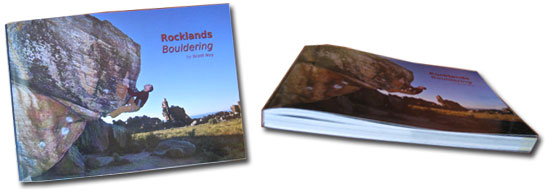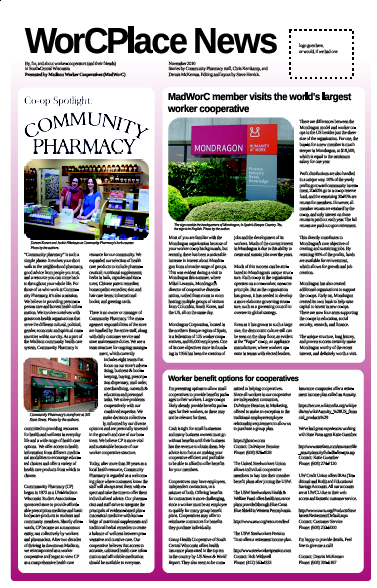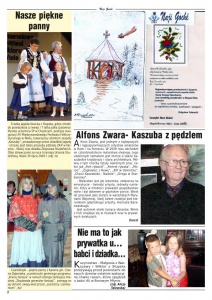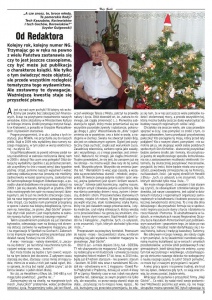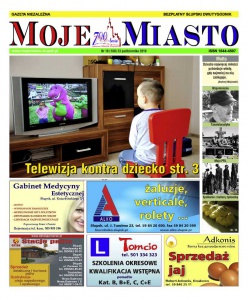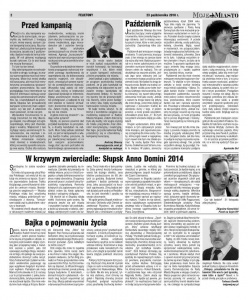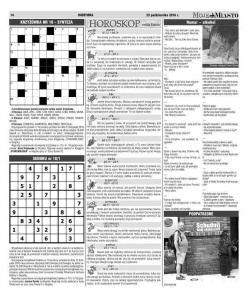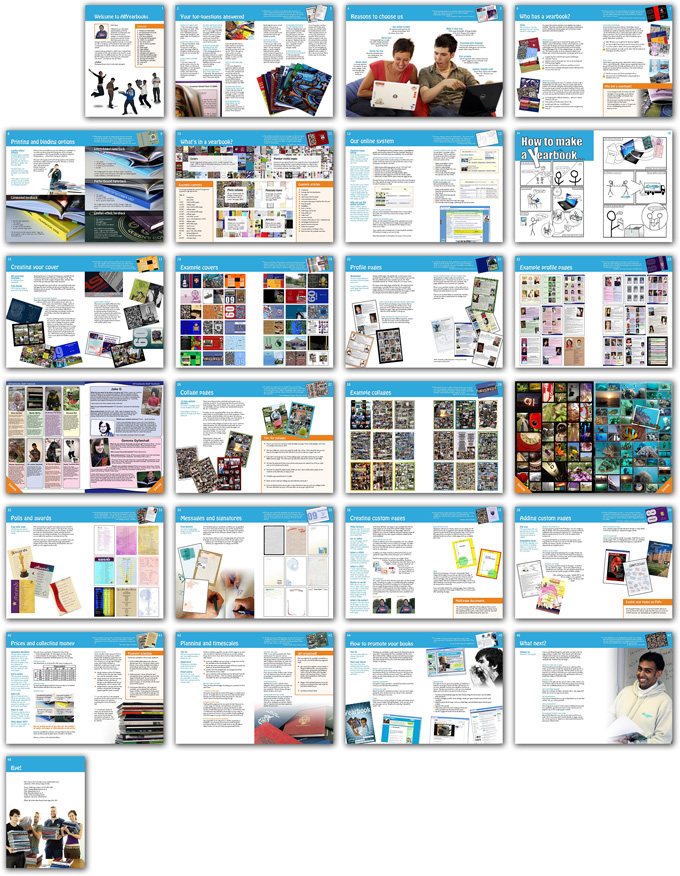Success Stories 2011: Difference between revisions
| Line 12: | Line 12: | ||
'''Date:''' January 2011 | '''Date:''' January 2011 | ||
My background in DTP started with Ventura Publishers for DOS in 2000. Yeah, it was great software, even for today I'd say (and it still used in that publishing house for special cases)! But DOS wasn't suitable for other tasks, so we have to move with mainstream... I dealt a bit with Adobe products, wasn't satisfied and completely migrate to Quark Xpress. | |||
At some moment (late 2009) I started to think about using some of *nix OS. But since one of my basic and most important task is DTP, my decision completely depended of one question: is there any usable DTP software for *nix systems? | |||
After a little googling I found Scribus, and my doubts had gone. | |||
In April 2010 I released first publication made with Scribus and continue using it till now. Our newspaper released weekly or once in two weeks, it has 4 pages, black and white offset printing. I send PDFs produced by Scribus to printshop and only once they had some troubles with output of one page. | |||
Besides this publication I use Scribus for other tasks: [http://fir.nes.ru/ru/people/students/Pages/NESPaper.aspx newspaper] and some teaching stuff for New Economical School of Russia, some booklets. | |||
I try to stay at front edge and use SVN version. It shows itself stable enough to be used in real production, not only for testing. | |||
There is still lack of some basic DTP features and a excessive vector graphic tools in 1.4svn. Performance and usability are also things to improve. But for several pages publication Scribus is great anyway! | |||
==Rocklands Bouldering, a 288-page climbing guidebook== | ==Rocklands Bouldering, a 288-page climbing guidebook== | ||
Revision as of 11:45, 13 January 2011
- Success Stories 2023
- Success Stories 2020
- Success Stories 2017
- Success Stories 2016
- Success Stories 2015
- Success Stories 2014
- Success Stories 2013
- Success Stories 2012
- Success Stories 2011
- Success Stories 2010
- Success Stories 2009
- Success Stories 2008
- Success Stories 2007
- Success Stories 2006
- Success Stories 2005-2004-2003
Introduction
Anyone is invited to describe her/his experience with successfully using Scribus in her/his projects. Please note: to report any unusual reasons you use Scribus join the ongoing discussion Stupid reasons we use Scribus. There is also a special page for placing links to your work: Made with Scribus. If you want to recommend a Scribus and/or PDF friendly print shop, please use Scribus Friendly Print Shops.
2010
Independent city newspaper "Dolgoprupny pages"
Reporter: Anton Alyab'ev (Антон Алябьев)
Date: January 2011
My background in DTP started with Ventura Publishers for DOS in 2000. Yeah, it was great software, even for today I'd say (and it still used in that publishing house for special cases)! But DOS wasn't suitable for other tasks, so we have to move with mainstream... I dealt a bit with Adobe products, wasn't satisfied and completely migrate to Quark Xpress. At some moment (late 2009) I started to think about using some of *nix OS. But since one of my basic and most important task is DTP, my decision completely depended of one question: is there any usable DTP software for *nix systems? After a little googling I found Scribus, and my doubts had gone. In April 2010 I released first publication made with Scribus and continue using it till now. Our newspaper released weekly or once in two weeks, it has 4 pages, black and white offset printing. I send PDFs produced by Scribus to printshop and only once they had some troubles with output of one page. Besides this publication I use Scribus for other tasks: newspaper and some teaching stuff for New Economical School of Russia, some booklets. I try to stay at front edge and use SVN version. It shows itself stable enough to be used in real production, not only for testing. There is still lack of some basic DTP features and a excessive vector graphic tools in 1.4svn. Performance and usability are also things to improve. But for several pages publication Scribus is great anyway!
Rocklands Bouldering, a 288-page climbing guidebook
Reporter: Stewart2
Date: December, 2010
My brother recently published a climbing guidebook for a world famousbouldering area in South Africa. Rocklands Bouldering is 288 pages, full colour, set in landscape format(A5), and features colour pictures and drawings throughout. I'm also busy on something similar - big up to the Scribus developers, you guys are doing an amazing job!
Here are two links (the second one includes pictures):
- http://www.rocklandsboulders.com/assets/features/show/RocklandsboulderingGuide
- http://www.climb.co.za/shop/order_rocklands.php
German Alpine Club (DAV), Local Section Ettlingen — periodical magazine
Reporter: Andreas Hünnebeck
Date: December, 2010
The magazine is sent to all members of the local section twice per year. You can download the current magazine and older ones here.
I started to create this magazine in 1992, using Winword on a Windows PC to write the text with place holders for the images. The print shop imported the text into Quark Express on a Mac and did the remaining prepress work.
In 1998 I switched to Staroffice 5.1 on a Linux PC and imported the scanned images into the document, but the print shop still had to do the prepress work in Quark Express. Later I changed to OpenOffice and created the PDF myself. Since the PDF contains images in RGB the print shop had to convert the images into CMYK before sending it to the rip, but this was much less work than before which lowered the costs substantially.
Plagued by the increasing number of bugs in OpenOffice 2 and 3 I finally switched to Scribus in April 2010 (using 1.3.3.12 on Kubuntu 9.04). I wrote several python scripts to create the tables used in the magazine. Eventually I was able to create a ready to print PDF for the print shop (which minimized the costs for the print) and a WEB version PDF for the homepage.
In November 2010 I upgraded to Scribus 1.3.8 (later to 1.3.9, two days before delivery) to create the next magazine (see WEB version PDF). Due to the python scripts I spared a lot of time to create all the tables.
Madison Worker Cooperatives — periodical newsposters
Reporter: Steve Herrick
Date: December, 2010
I live in Madison, Wisconsin, which has a relatively high concentration of worker co-ops. Our network (or business association) is called Madison Worker Cooperatives, which is usually shortened to MadWorC. The website is madword.orc.
I've been using Scribus in a somewhat unusual way: I make newsletters that are printed as posters. I design them specifically so co-ops can hang it up in their workspaces, so people can read the poster on the wall when they're on break. The posters are 13x19 inches.
The workflow is pretty simple: people in the organization write the articles, and I lay them out in Scribus (with a little help from OpenOffice.org, Inkscape, and the GIMP). We've settled into a pattern of one co-op feature per edition, with one or two other articles as well. The newsposters are published every other month, by one of the local worker co-ops.
Pro Velo Bern — 15 bike tours
Reporter: Christoph Bloch
Date: December, 2010
http://www.provelobern.ch > Publikationen > Touren (unfortunately only 2 out of 15 sheets are public due to copyright restraints.)
Pro Velo Bern, a bicycle advocacy NGO from Bern, Switzerland, successfully published 15 bike tours in 2010. They give you ideas for nice bike rides in the region of Bern and come as pdf files in A3 format. They are still readable if printed on A4; alternative files split into two A4 pages each are also available. Paper copies were produced as giveaways on one of those multi-machines that look like old-fashioned copiers but can read pdf files from a usb stick. Of course the files were created with Scribus! (with a little help from the Gimp, OpenOffice.org and Perl)
All the work was done by motivated yet totally inexperienced amateurs. We ran into quite a lot of trouble*, but whenever we asked the list, people were very helpful. We learned a lot. So thank you all!
*Xerox wouldn't print Scribus' PDF - handcrafted svg paths import in nano-size - characters scrambled when printing - style copies proliferating - dotted lines only possible in unstable version - line styles don't allow dotted lines - sla files not readable on some computers despite of identical Scribus versions - etc etc etc. But we succeeded after all!!!
Clan Mackintosh of North Americas, a quarterly newsletter
Reporter: George McIntosh
Date: December, 2010
I am the editor of the quarterly newsletter for Clan Mackintosh of North America with over 500 members in the United States, Canada and Scotland.
I have used several desk top publishers over the years and had been using Pagemaker for the past few years. When I bought a new PC, Pagemaker would not run on it, Windows 7 x64, so I started looking for another DTP. I came across Scribus and have produced the past three issues with it. I had the usual newbee problems but thanks to this great mailing list deadlines were met and people like the results. I produce two versions, a printed one in greyscale, due to the clan budget, and a web version in color. It has been a pretty painless transition and I recommend Scribus to others.
Creating Book Covers with Scribus
Reporter: John R. Culleton
Date: December, 2010
I wrote an e-book on “Creating Book Covers with Scribus” which I posted on Booklocker. It sold over 100 copies. Using Scribus 1.5.0 I created the cover for “Death Wore Black”, a police procedural novel in the PDF X/1-a:2001 format required by LSI, perhaps the largest POD printer in the world. LSI accepted it without rasterizing the cover. Two other publishers doubted this success so I sent them copies to prove the point.
Naji Gòchë, a social and cultural magazine in Polish and Kashubian language
Reporter: cezaryece
Date: March, 2010
Home Page
Issue 42, Winter 2010 (PDF)
Previously the magazine had been made with Corel Ventura 8, but due to some hyphenation problems we decided to leave it and the last issue (winter 2010) was made with Scribus 1.5 (built from SVN) without any major problems. It contains 155 pages full of text and photos. Due to low funds there is currently no printed, but only the free download version, but in the near future we plan to go back to the paper issue.
Moje miasto, a biweekly magazine in Polish language
Reporter: cezaryece
Date: March, 2010
A local biweekly newspaper from Słupsk in Poland, made with Scribus since December 2009 (following Corel Ventura 8). Printing to paper has been done by a printing house from PDF files without any problems. Half of each issue are full color pages, the leftover is black-white (mainly 16 pages issues, sometimes 24 pages). Started with Scribus 1.5 SVN, but now it is made with Scribus 1.3.8 due to performance in text editing. Advertisements have been made with CorelDRAW (as JPG files), text files arrive in Word format and are converted with Open Office including some cleanup. The sudoku game is made with Inkscape as an EPS file. The big advantage of migrating to Scribus is the Short Words plugin — Ventura has not such a feature at all.
AllYearbooks 2010 Information Pack
Reporter: Jake Gordon
Date: February, 2010
AllYearbooks is a leading yearbook producer in the UK. We had been weighing up InDesign vs Scribus for some time but with version 1.3.6 Scribus really took the lead for us. We created this information pack (marketing material) entirely in house. We used Scribus 1.3.6svn as it included important features and bug fixes which we required.
Our information pack is 48 pages long, and as we needed to create it as quick as possible we created 5 smaller files with up to 10 pages each, rather than working with one big file. This enabled two of us to work on the pack concurrently, connecting to a Samba share over 1Gbps ethernet.
After sending the document to be printed in both paperback and laminated hardback forms, I used the 'import page' feature to collate the five files into one, to make future revisions more logical.
You can find also download the PDF of the information pack, which was exported using Scribus' PDF export tool with all images compressed to a maximum of 72dpi.
